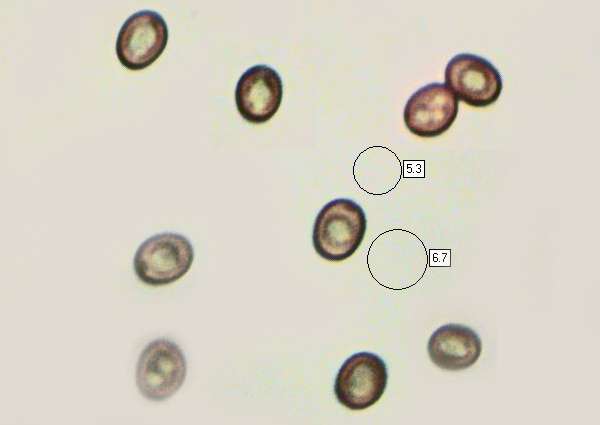Agaricus bernardii Quél. - Salty Mushroom
Phylum: Basidiomycota - Class: Agaricomycetes - Order: Agaricales - Family: Agaricaceae
Distribution - Taxonomic History - Etymology - Identification - Culinary Notes - Reference Sources
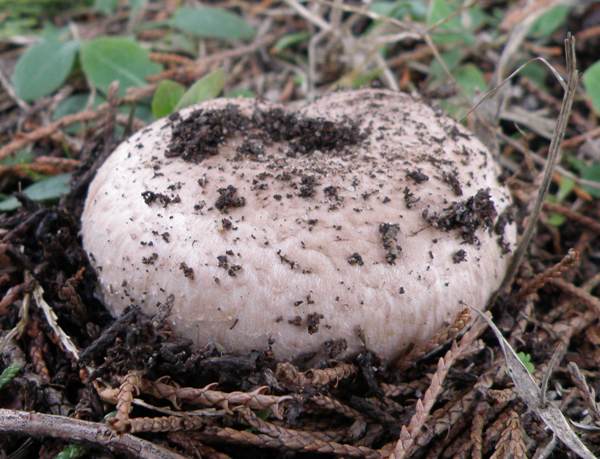
Distinctive large brown cap scales and a coastal grassland habitat make this a fairly easy species to identify.
Distribution
Being remarkably tolerant of salt-laden air, this large edible mushroom is occasionally seen in sand-dune grassland very close to beaches. The specimen shown abovew was seen on the west coast of France.
Salty Mushrooms can occur as solitary specimens, but more often they are in groups jostling one another for space, and as a result some of the caps develop contorted margins.
Taxonomic history
Described and given the scientific name Agaricus bernardi by Lucien Quélet (often written as Quelet without the accent) in 1878, the Salty Mushroom looks similar to several other species, but its reddening flesh (when cut) is at least some help towards identification. The currently-accepted scientific name Agaricus bernardii dates from an 1878 publication by Lucien Quélet.
Synonyms of Agaricus bernardii include Psalliota bernardi Quél., Fungus bernardii (Quél.) Kuntze and Agaricus campestris subsp. bernardii (Quél.) Konrad & Maubl.
Etymology
The specific epithet bernardii is a reference to G. Bernard, the finder of the collection from La Rochelle, France, that was used by Lucien Quélet in producing his original description of this species as Psaliota bernardii.
Identification guide
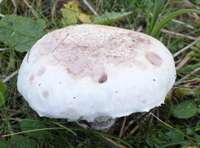 |
Cap7 to 15cm across; initially hemispherical, becoming convex; surface background white, covered in coarse brown scales that give it a cracked appearance; margin slightly inrolled; white flesh turns reddish when cut. |
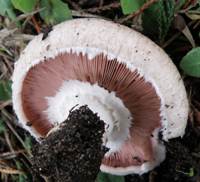 |
GillsFree; crowded; pink, becoming chocolate-brown as the spores mature. Stem4 to 8cm long and 2 to 4cm diameter; narrow sheathing ring with an upturned rim. |
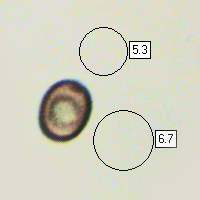 |
SporesBroadly ovoid, 5.5-7 x 5-5.5µm. Spore printChocolate-brown. |
Odour/taste |
Taste not distinctive. Strong odour of aniseed. |
Habitat & Ecological role |
In grassland, including coastal dune slacks. |
Season |
July to November. |
Occurrence |
Infrequent. |
Similar species |
The Prince Agaricus augustus is usually somewhat larger and has a purple-brown spore print; it is a mushroom of forests and woodland edges. |
Culinary Notes
Pewrhaps because it is an uncommon find, Agaricus bernardii is is not generaly considered to be a highly-prized edible mushroom.
Reference Sources
Fascinated by Fungi, 2nd Edition, Pat O'Reilly 2016, reprinted by Coch-y-bonddu Books in 2022.
BMS List of English Names for Fungi
The genus Agaricus in Britain, 3rd Edition, self-published, Geoffrey Kibby 2011
Dictionary of the Fungi; Paul M. Kirk, Paul F. Cannon, David W. Minter and J. A. Stalpers; CABI, 2008
Taxonomic history and synonym information on these pages is drawn from many sources but in particular from the British Mycological Society's GB Checklist of Fungi.
Fascinated by Fungi. Back by popular demand, Pat O'Reilly's best-selling 450-page hardback book is available now. The latest second edition was republished with a sparkling new cover design in September 2022 by Coch-y-Bonddu Books. Full details and copies are available from the publisher's online bookshop...
